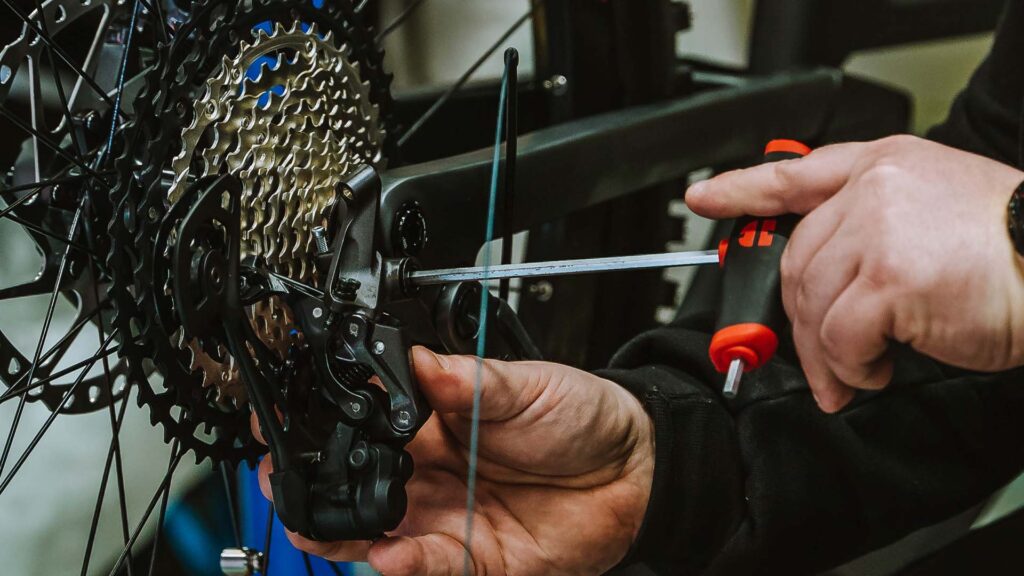E-bike storage and maintenance
E-bike storage and maintenance
The maintenance of an e-bike does not differ much from that of a traditional bicycle: the bike should be cleaned, tyres inflated and chain oiled on a regular basis. However, the maintenance of the motor and battery as well as software updates should be left to a professional. Storing and charging the battery correctly is essential for the durability and longevity of the e-bike.
Why and how often should an e-bike be serviced?
Regular and correct maintenance of the e-bike has a significant impact on the bike staying in good condition. This will help to avoid unexpected problems and reduce maintenance costs in the long term.
- FIRST SERVICE: When the e-bike is first used, it is still taking shape; the spokes may become loose and the cables may stretch. It is also a good idea to check the electrical system soon after starting to use it. As with traditional bicycles, a new e-bike should therefore undergo its first service when it has been ridden for approximately 100–300 kilometres or used for 5–15 hours. At the latest, the first service should be carried out a few months after starting cycling.
- SEASONAL MAINTENANCE: An e-bike should be serviced by a professional every 1,000–2,000 kilometres or at least once a year. At that time, the electrical system will also be checked and the firmware updated.
- FULL MAINTENANCE: Full maintenance that is even more thorough than seasonal maintenance should be done on your e-bike every few years or roughly every 5,000–6,000 kilometres.


How should you service an e-bike yourself?
Maintaining an e-bike at home does not differ much from a traditional bicycle, but you should leave servicing the motor and battery and installing the firmware updates to a professional.
However, regular self-maintenance of an e-bike is at least as important as with a traditional bicycle – perhaps even more so as the weight and power of the bike mean that wear and tear is higher than usual.
CLEANING AN E-BIKE: It is a good idea to clean the bike often enough, as dirt will wear out moving parts in particular. All you need to wash your bike is a bucket of warm water, a little bicycle cleaner and a rag or sponge and brush.
- First, clean the frame, saddle and handlebar with a rag or sponge. The tyres and drive system should be brushed clean.
- Remember to watch out for sensitive parts and avoid the cleaner from getting into bearings or brakes. Also, the areas of the electric motor or battery should not be splashed with water.
- Finally, rinse and dry the bike thoroughly.
- It is not advisable to use a high-pressure cleaner to wash the bike, as it can cause damage.
TYRE INSPECTION: Check the condition of the tyres. If there are cracks in the tyres or the surface is worn smooth, it is time to replace the tyre. Also check that the wheels rotate freely. Inflate the tyres to the correct pressure. Tyre pressure has a significant impact on your ride experience, and suitable tyre pressure is influenced by factors such as riding style, rider and cargo weight, terrain and weather. Suitable tyre pressures can be found by experimenting, but a good starting point can be found on the sidewall of the tyre, where the recommended tyre pressure limits are indicated. Make sure that you always stay within these limits.
LUBRICATING THE CHAINS OF AN E-BIKE: Before lubricating, it is advisable to clean the chains with degreaser and brush at least occasionally. It is a good idea to add lubricant to the inner surface of the chain on top of the rollers. Let the substance act for a while and wipe off the excess oil with a cloth. Be careful not to use too much lubricant!
GEARS AND BRAKES: The maintenance of gears and brakes should be left to a professional unless you are absolutely certain that you know what you are doing. However, the brakes and gears should be checked at every service and, if necessary, the brake cable can be tightened.

How to correctly store an e-bike?
The storage of an e-bike has impacts on the functioning and longevity of the battery in particular. The most important thing is to remove the battery from the bike and always store and charge it at room temperature.
The ideal storage location for an e-bike is dry and warm, but it can also be stored outdoors without the battery). However, it is important to protect your bike from rain and snow. In winter, the bike should not be stored in freezing temperature so as not to damage the electrical parts. Also, a boiler or heat exchange room is not a suitable place for a bike, as they are usually too hot.
Where and how should the e-bike battery be charged?
- The battery should always be stored and charged at room temperature. When you bring the battery from cold to warm, you should wait a while before charging. The battery should never be left to charge unsupervised, and it should always be charged using the battery’s own charger.
- The battery should never be allowed to go completely flat or even repeatedly below 20% of the charge. If the bike is left unused for a long time, it is advisable to check the battery and charge it every few months. However, it is not advisable to store the battery fully charged; the optimum storage charge is approx. 50–70%.
- An e-bike’s battery should never be left empty in freezing temperatures, as this can render it unusable!



